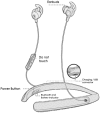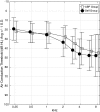Validation of a Self-Fitting Method for Over-the-Counter Hearing Aids
- PMID: 32003285
- PMCID: PMC7099667
- DOI: 10.1177/2331216519900589
Validation of a Self-Fitting Method for Over-the-Counter Hearing Aids
Abstract
In common practice, hearing aids are fitted by a clinician who measures an audiogram and uses it to generate prescriptive gain and output targets. This report describes an alternative method where users select their own signal processing parameters using an interface consisting of two wheels that optimally map to simultaneous control of gain and compression in each frequency band. The real-world performance of this approach was evaluated via a take-home field trial. Participants with hearing loss were fitted using clinical best practices (audiogram, fit to target, real-ear verification, and subsequent fine tuning). Then, in their everyday lives over the course of a month, participants either selected their own parameters using this new interface (Self group; n = 38) or used the parameters selected by the clinician with limited control (Audiologist Best Practices Group; n = 37). On average, the gain selected by the Self group was within 1.8 dB overall and 5.6 dB per band of that selected by the audiologist. Participants in the Self group reported better sound quality than did those in the Audiologist Best Practices group. In blind sound quality comparisons conducted in the field, participants in the Self group slightly preferred the parameters they selected over those selected by the clinician. Finally, there were no differences between groups in terms of standard clinical measures of hearing aid benefit or speech perception in noise. Overall, the results indicate that it is possible for users to select effective amplification parameters by themselves using a simple interface that maps to key hearing aid signal processing parameters.
Keywords: hearing aid benefit; hearing aids; over-the-counter hearing aids; self-fitting hearing aids.
Figures

















Similar articles
-
Effectiveness of an Over-the-Counter Self-fitting Hearing Aid Compared With an Audiologist-Fitted Hearing Aid: A Randomized Clinical Trial.JAMA Otolaryngol Head Neck Surg. 2023 Jun 1;149(6):522-530. doi: 10.1001/jamaoto.2023.0376. JAMA Otolaryngol Head Neck Surg. 2023. PMID: 37052929 Free PMC article. Clinical Trial.
-
Differences in Word and Phoneme Recognition in Quiet, Sentence Recognition in Noise, and Subjective Outcomes between Manufacturer First-Fit and Hearing Aids Programmed to NAL-NL2 Using Real-Ear Measures.J Am Acad Audiol. 2018 Sep;29(8):706-721. doi: 10.3766/jaaa.17005. J Am Acad Audiol. 2018. PMID: 30222541 Clinical Trial.
-
Transitioning hearing aid users with severe and profound loss to a new gain/frequency response: benefit, perception, and acceptance.J Am Acad Audiol. 2011 Mar;22(3):168-80. doi: 10.3766/jaaa.22.3.5. J Am Acad Audiol. 2011. PMID: 21545769 Clinical Trial.
-
Otology: Hearing Loss.FP Essent. 2024 Jul;542:7-13. FP Essent. 2024. PMID: 39018125 Review.
-
Chapter 3: Setting the Hearing Aid Response and Verifying Signal Processing and Features in the Test Box.Semin Hear. 2024 May 17;45(2):172-204. doi: 10.1055/s-0044-1786522. eCollection 2024 May. Semin Hear. 2024. PMID: 38855347 Free PMC article. Review.
Cited by
-
Statistical Considerations for Analyzing Ecological Momentary Assessment Data.J Speech Lang Hear Res. 2022 Jan 12;65(1):344-360. doi: 10.1044/2021_JSLHR-21-00081. Epub 2021 Dec 15. J Speech Lang Hear Res. 2022. PMID: 34910571 Free PMC article. Review.
-
Prioritizing research on over-the-counter (OTC) hearing aids for age-related hearing loss.Front Aging. 2023 Mar 23;4:1105879. doi: 10.3389/fragi.2023.1105879. eCollection 2023. Front Aging. 2023. PMID: 37033402 Free PMC article.
-
Potential Roles of Audiologists Supporting Patients' OTC Hearing Aid Journey.Semin Hear. 2025 Apr 16;46(1):10-18. doi: 10.1055/s-0045-1806791. eCollection 2025 Feb. Semin Hear. 2025. PMID: 40290594 Review.
-
Preserving the Role of the Audiologist in a Clinical Technology, Consumer Channel, Clinical Service Model of Hearing Healthcare.Semin Hear. 2023 Jun 14;44(3):302-318. doi: 10.1055/s-0043-1769627. eCollection 2023 Aug. Semin Hear. 2023. PMID: 37484986 Free PMC article. Review.
-
The effect of stimulus duration on preferences for gain adjustments when listening to speech.Int J Audiol. 2022 Nov;61(11):940-947. doi: 10.1080/14992027.2021.1998676. Epub 2021 Nov 11. Int J Audiol. 2022. PMID: 34762024 Free PMC article.
References
-
- Abrams H., Edwards B., Valentine S., Fitz K. (2011). A patient-adjusted fine-tuning approach for optimizing hearing aid response. Hearing Review, 18(3), 18–27.
-
- American National Standards Institute/Consumer Technology Association. (2017). Personal Sound Amplification Performance Criteria (ANSI/CTA 2051-2017). Retrieved from https://webstore.ansi.org/standards/ansi/cta20512017 ansi+&cd=&hl=en&ct=...
-
- Banerjee S. (2011). Hearing aids in the real world: Typical automatic behavior of expansion, directionality, and noise management. Journal of the American Academy of Audiology, 22, 34–48. doi:10.3766/jaaa.22.1.5 - PubMed
Publication types
MeSH terms
LinkOut - more resources
Full Text Sources
Medical
Miscellaneous

